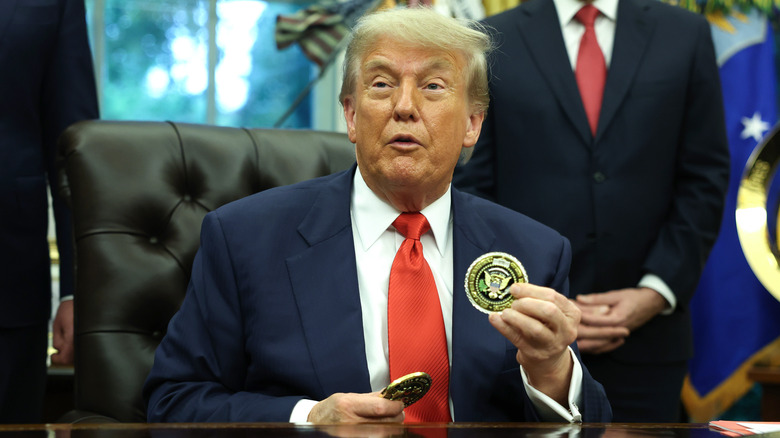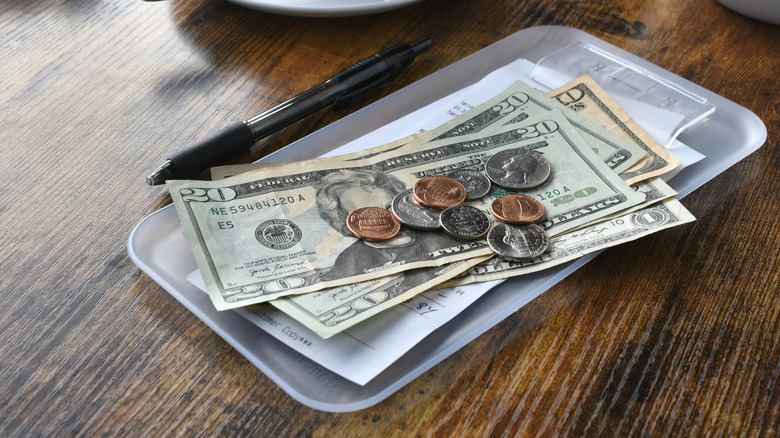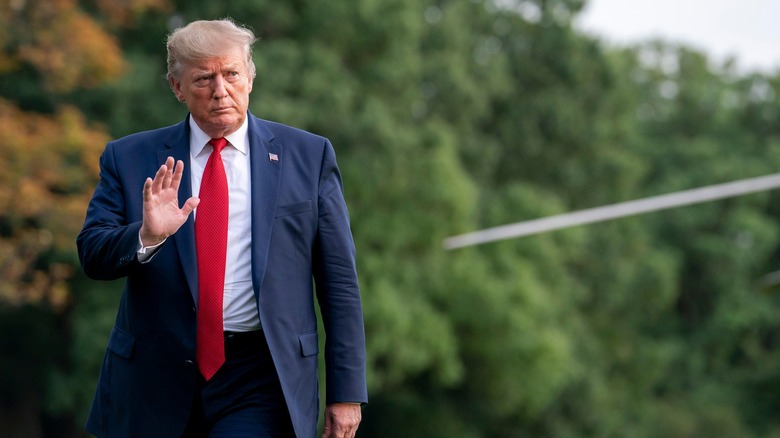Trump's $1 Coin Would Automatically Break With This American Tradition
Not even a government shutdown — one that's furloughed thousands of federal workers and possibly affected Social Security payments for the newly retired – could prevent U.S. Treasurer Brandon Beach from reposting images on X that featured President Donald Trump on a $1 coin. And it didn't stop there. Various Trump officials went on to defend and praise the possibility of Trump's face appearing on a coin commemorating the United States' 250th anniversary.
This wouldn't be the first time Trump's image has been suggested as decoration for U.S. currency. In June 2024, Congressman Paul Gosar pushed legislation that would bring back the $500 bill with Trump's face on it. This was followed in February 2025 by a proposal from Congressman Joe Wilson for a Trump-adorned $250 bill. And Trump's face is on the Trump Gold Card and Trump Platinum Card, intended to be issued by the federal government as residency cards for wealthy foreigners able to pay $1 million and $5 million, respectively.
Yet it still breaks tradition to put a living U.S. president's image on money. "Not featuring current presidents on coins is an important and enduring part of the United States' history as a republic," American University Associate Professor of Economics Gabriel Mathy told Politifact, adding: "The United States was founded as a republic, and the founders wanted to avoid making the president into a monarch."
Who gets to appear on limited edition coins?
The tradition didn't stop the faces of living Lincoln administration officials from being placed on Union money during and after the Civil War. Among these figures was controversial National Currency Bureau superintendent Spencer Clark, who had his own face engraved on the five cent bill in 1866 after Congress authorized the image of the late explorer William Clark to appear on fractional paper money. (The congressional bill reportedly just said "Clark.") In response, Congress passed a law that year banning the image of "any living person" on bonds, securities, notes, and "fractional or postal currency."
Coins were not mentioned in the 1866 law, however. That could be why other living folks have occasionally appeared on limited edition coins. This includes President Calvin Coolidge, who appeared on a 50 cent coin issued in 1926 while he was still alive and in office. Struck during the 150th anniversary of the United States' birth, the coins featured the heads of George Washington and Coolidge, but did so poorly that most of those issued were returned to the mint and melted.
The $1 Coin Act of 2005 issued an outright ban on striking the image of a living former or current president on presidential coins. The law also contains a 2007 clause that prohibits the inclusion of former presidents who have been dead for less than two years.
A future collector's item?
However, the proposed $1 coin with Trump's image is guided by another law: the Circulating Collectible Coin Redesign Act of 2020, meant to honor the 250th anniversary of the country's founding. These coins aren't meant to be used as regular money. Instead, they are commemorative coins sold by the federal government in limited numbers to raise money for philanthropic projects such as maintaining national monuments or supporting Olympic programs. In short, they are supposed to be valuable collector's coins that eventually become so rare that you'd regret throwing them away – though that didn't work out for the limited-edition Washington-Coolidge coins issued (and melted) 100 years ago.
A Treasury Department spokesperson told CNBC that the proposed coin "reflects well the enduring spirt of our country and democracy, even in the face of immense obstacles." These "obstacles" may be in reference to the assassination attempt on Trump in Butler, Pennsylvania in July 2024, after which Trump raised his fist while being covered by Secret Service agents. The reverse of Trump's $1 coin shows him standing in front of the American flag with his fist held up and the word "fight" repeated three times above him.
But Trump's defiant moment might not be allowed either way, as the Circulating Collectible Coin Redesign Act of 2020 states that "no portrait of a living person may be included" on the coin's reverse side.


